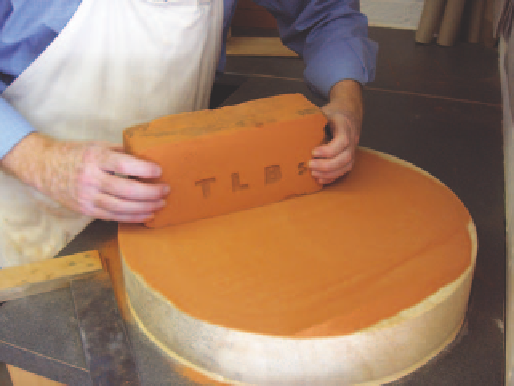Agriculture Reference
In-Depth Information
action, is always a circular motion across the stone surface. It is likely that the
first rubbing stones were utilised from old grinding-wheels. It was primarily uti-
lised to rub the bed and stretcher faces of a rubber to be at right angles to one
another, prior to being scribed to the templet and then cut to shape (Fig. 80).
Moxon also describes bricks rubbed for cutting and those not being cut. He
describes preparing ashlared bricks as 'rubbed returns' for quoins, and as head-
ers and stretchers for the remaining facework. Some of these would only be
marked to a templet - 'scribed' - and then simply rubbed down to the line and
required size. This, Langley (1749, 286) describes 50 years later:
Figure 80
Rubbing an oversized
TLB on the rubbing
stone prior to squaring
…of various kinds, viz., Rubed only, and set in Front Mortar; or gaged, rubed
and set in Putty. Those which are rubbed only are chiefly the sides or jaumbs of
Windows and the external angles or quoins of buildings.
'Front mortar' was the well-screened standard bricklaying mortar reserved
for the outer-face of brickwork, including ashlared gauged work with 5 mm
(¼ inch) bed joints, on principal elevations, as opposed to a generally weaker
mortar of crudely slaked lime and coarse sand for 'backing-up' or internal use
on the building.
5. A Square, to try the bed of the Brick, (viz. That fide which lies in the Morter)
with the fuperficies or face of the Brick, to make the Brick fquare, or at Rect-angles
one fide with the other, which is done by rubbing it on the Rub-ftone till it exactly
anfwers, or fits to the Square.
Craftsmen now use a carpenter's 'try-square', whereas Moxon's plate shows a large
iron square, though its use for preparing rubbers remains as Moxon describes.
'Trying', or testing, the brick bed, stretcher and header faces after they had been

